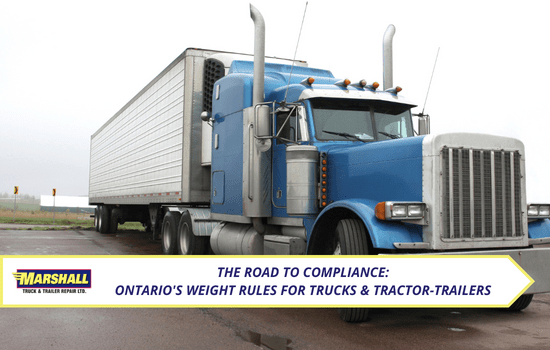Operating a tractor-trailer in Ontario means adhering to specific weight regulations to ensure safety and preserve road infrastructure. We’re keeping you informed by outlining the rules to help truck drivers and fleet managers navigate the weight regulations with confidence.
Navigating Truck and Tractor-Trailer Weight Rules in Ontario, Canada
 Operating a tractor-trailer in Ontario, comes with various regulations and responsibilities, especially when it comes to weight limits. Ensuring compliance with these rules is essential for safety, road preservation, and avoiding legal issues. In this blog, we will delve into the tractor-trailer weight rules to help truck drivers and fleet managers better understand their obligations and responsibilities.
Operating a tractor-trailer in Ontario, comes with various regulations and responsibilities, especially when it comes to weight limits. Ensuring compliance with these rules is essential for safety, road preservation, and avoiding legal issues. In this blog, we will delve into the tractor-trailer weight rules to help truck drivers and fleet managers better understand their obligations and responsibilities.
Gross Vehicle Weight Rating (GVWR)
The Gross Vehicle Weight Rating (GVWR) is a crucial factor when it comes to tractor-trailer weight regulations in Ontario. The GVWR refers to the maximum allowable weight of a fully loaded vehicle, including the truck, trailer, cargo, and passengers. It is essential to know the GVWR of your tractor-trailer combination to determine compliance with weight limits.
Weight Limits for Trucks and Tractor-Trailers
- Gross Vehicle Weight Rating (GVWR): The GVWR of a tractor-trailer in Ontario typically ranges from 40,000 kg to 63,500 kg, depending on the type of truck and trailer combination. It's crucial to ensure that your loaded vehicle weight does not exceed this limit.
- Axle Weight Limits: Ontario has specific axle weight limits based on the number of axles and axle configurations. For instance, a single axle is typically limited to 9,000 kg, while a tandem axle is limited to 17,000 kg. These limits are in place to prevent excessive stress on road infrastructure.
- Tire Weight Limits: Ensure that your tractor-trailer's tires are rated to carry the weight imposed on them. Overloading tires can lead to premature wear and safety hazards.
- Bridge Formula: Ontario follows a bridge formula that calculates the maximum allowable weight based on the distance between axles. The longer the distance between axles, the higher the allowable weight. Understanding this formula is crucial to avoid overloading.
Permits and Exceptions
In some cases, you may need special permits to exceed standard weight limits. Ontario offers permits for specific situations, such as transporting oversized or overweight loads. However, obtaining permits often requires additional fees and compliance with specific conditions.
Safety Considerations
Even if your tractor-trailer is within legal weight limits, safety should always be a top priority. Ensure that your cargo is properly secured, and distributed evenly and that the trailer's load is within its weight-bearing capacity. Overloaded or improperly balanced trailers can affect stability and handling, leading to accidents.
Enforcement and Penalties
Ontario's Ministry of Transportation is responsible for enforcing weight regulations. Violations can result in fines, penalties, and even vehicle impoundment. Fleet managers and truck drivers should stay informed about weight regulations and conduct regular weight checks to avoid violations.
If this topic interests you, be sure to read, Mastering SPIF Weight Requirements in Ontario: A Transporter's Handbook.
